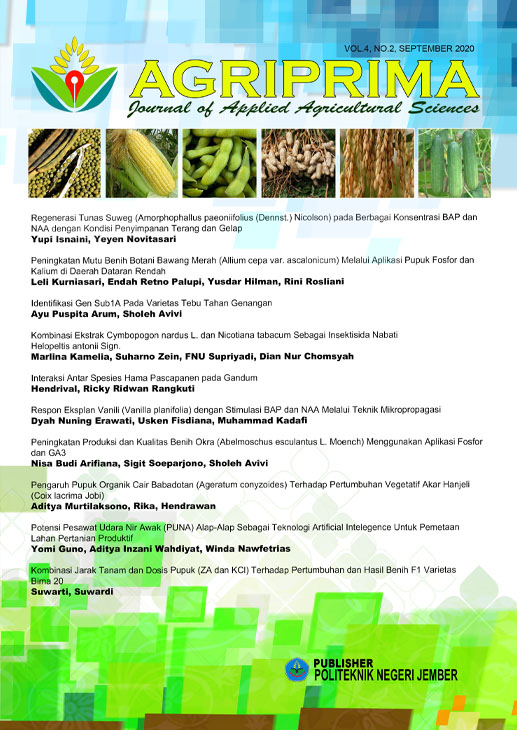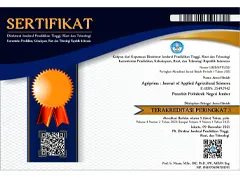Regenerasi Tunas Suweg (Amorphophallus paeoniifolius (Dennst.) Nicolson) pada Berbagai Konsentrasi BAP dan NAA dengan Kondisi Penyimpanan Terang dan Gelap
DOI:
10.25047/agriprima.v4i2.375Downloads
Abstract
Amorphopallus paeoniifolius atau suweg merupakan salah satu jenis dari suku Araceae yang umbinya berpotensi untuk dikembangkan sebagai alternatif pangan karena memiliki kandungan gizi yang baik dan indeks glikemik yang rendah. Namun, perbanyakan suweg terkendala dalam ketersediaan bibitnya sehingga dibutuhkan alternatif perbanyakan, salah satunya dengan teknik kultur jaringan. Penelitian ini bertujuan untuk mendapatkan kombinasi media, jenis eksplan dan kondisi kultur yang optimal untuk perbanyakan suweg secara in vitro. Penelitian dilakukan dengan dua percobaan. Percobaan pertama yaitu regenerasi tunas dari eksplan tangkai daun yang ditanam pada media Murashige dan Skoog (MS) yang ditambahkan dengan BAP (0, 1, 2, dan 4 mg/l) dan NAA (0 dan 0,5 mg/l). Percobaan kedua yaitu regenerasi tunas dari eksplan tangkai daun dan kalus pada kondisi gelap dan terang. Hasil penelitian menunjukkan bahwa media MS dengan penambahan 2 mg/l BAP dan 0,5 mg/l NAA merupakan media yang paling baik bagi eksplan tangkai daun dalam pembentukan kalus, tunas dan akar yang ditandai dengan jumlah masing-masing adalah 75%, 50% dan 56,67%. Selanjutnya, eksplan berupa kalus lebih mudah memberikan respon membentuk tunas dan akar dibandingkan dengan tangkai daun, baik pada kondisi ruang penyimpanan gelap maupun terang.
Keywords:
Amorphophallus paeoniifolius Kultur jaringan Pangan alternatif SuwegReferences
Ali, A., Rizwan, M., Majid, A., Saleem, A., & Naveed, N. H. (2012). Effect of media type and explants source on micropropagation of Dalbergia sissoo: A tree of medicinal importance. Journal of Medicinal Plants Research, 6(9), 1742–1751. https://doi.org/10.5897/JMPR11.1551
Amphawan, R., Pookmanee, T., & Topoonyanont, N. (2001). Influence of auxin on micropropagation of Amorphophallus oncophyllus prain ex Hook. F. In vitro. Proceeding of the 3rd Maejo University Annual Conference, 567–579.
Bhatia, N., Bozorg, B., Larsson, A., Ohno, C., Jönsson, H., & Heisler, M. G. (2016). Auxin Acts through MONOPTEROS to Regulate Plant Cell Polarity and Pattern Phyllotaxis. Current Biology, 26(23), 3202–3208. https://doi.org/10.1016/j.cub.2016.09.044
Chen, C. (2004). Humidity in Plant Tissue Culture Vessels. Biosystems Engineering, 88(2), 231–241. https://doi.org/10.1016/j.biosystemseng.2004.02.007
Chen, Y.-M., Huang, J.-Z., Hou, T.-W., & Pan, I.-C. (2019). Effects of light intensity and plant growth regulators on callus proliferation and shoot regeneration in the ornamental succulent Haworthia. Botanical Studies, 60(1), 10. https://doi.org/10.1186/s40529-019-0257-y
Faridah, D. N. (2005). Sifat Fisiko Kimia Tepung Suweg (Amorphophallus campanulatus B1.) Dan Indeks Glisemiknya. Teknologi Dan Industri Pangan, 16(3), 254–259.
Hasanah, U., Hadi, E. P., & Hidayah, A. (2014). Keanekaragaman dan Pemanfaatan Ubi-Ubian sebagai Alternatif Tanaman Pangan di Kecamatan Bantarkawung Kabupaten Brebes Diversity and uses of Tubers as Alternative Food Sources in Bantarkawung Brebes Regency. Biosfera, 31(2), 61–70. https://doi.org/10.20884/1.mib.2014.31.2.215
Hu, J. B., Liu, J., Xie, C. H., & Gao, X. X. (2006). Corm induction and multiplication of Amorphophallus albus in vitro. The Journal of Horticultural Science and Biotechnology, 81(5), 859–863. https://doi.org/10.1080/14620316.2006.11512150
Hu, J. B., Liu, J., Yan, H. B., & Xie, C. H. (2005). Histological observations of morphogenesis in petiole derived callus of Amorphophallus rivieri Durieu in vitro. Plant Cell Reports, 24(11), 642–648. https://doi.org/10.1007/s00299-005-0002-8
Hu, J., Gao, X., Liu, J., Xie, C., & Li, J. (2008). Plant regeneration from petiole callus of Amorphophallus albus and analysis of somaclonal variation of regenerated plants by RAPD and ISSR markers. Botanical Studies, 49(3), 189–197.
Imelda, M. (2008). Shoot regeneration from leaf petioles of iles-iles (Amorphophallus muelleri Blume). Biodiversitas, Journal of Biological Diversity, 9(3), 173–176. https://doi.org/10.13057/biodiv/d090304
Imelda, M., Wulansari, A., & Poerba, Y. S. (2007). Mikropropagasi tanaman Iles-iles (Amorphophallus muelleri Blume). Berita Biologi, 8(4), 271–277. https://doi.org/10.14203/beritabiologi.v8i4.2117
Irawati. (2000). Diferensiasi Berbagai Macam Eksplan Pada Perbanyakan Philodendron goeldii ( Araceae ) Secara In-Vitro [ Differentiation of Several Explants on In-vitro Propagation of Philodendron goeldii ( Araceae )]. Berita Biologi, 5(April), 69–75. https://doi.org/10.14203/beritabiologi.v5i1.1100
Irawati. (2005). Pembentukan Kalus dan Embriogenesis Kultur Pelepah Daun dan Daun Caladium Hibrida [ Callus formation and embryogenesis of petiole and leaf cultures of Caladium hybrid ]. Berita Biologi, 7(5), 257–261. https://doi.org/10.14203/beritabiologi.v7i5.876
Irawati. (2011). Micropropagation of A titanum Becc. (Araceae). Buletin Kebun Raya, 14(1), 29–36.
Irawati, Arditti, J., & Nyman, L. P. (1986). In Vitro Propagation of the Elephant Yam, Amorphophallus campanulatus var. hortensis Backer (Araceae). Annals of Botany, 57(1), 11–17. https://doi.org/10.1093/oxfordjournals.aob.a087088
Isnaini, Y., Wahyuni, S., & Rahayu, E. M. Della. (2010). Keberadaan dan Pemanfaatan Umbi Suweg (Amorphophallus paeoniifolius Dennst. Nicolson) di beberapa daerah di Jawa Tengah dan Jawa Timur. Prosiding Seminar Nasional Green Technology, D60–D65.
Isnaini, Y., Wahyuni, S., & Yuzammi. (2012). Aplikasi Kultur Jaringan untuk Perbanyakan Araceae Berpotensi Pangan. Prosiding Simposium Dan Seminar Bersama PERAGI-PERHORTI-PERIPI-HIGI “Mendukung Kedaulatan Pangan Dan Energi Yang Berkelanjutan,” 302–306.
Kamala, S., & Makeshkumar, T. (2014). Optimization of in vitro regeneration and microcorm induction in elephant foot yam (Amorphophallus paeoniifolius). African Journal of Biotechnology, 13(49), 4508–4514. https://doi.org/10.5897/AJB2014.14141
Kayal, D., Chatterjee, A., & Datta, R. (2015). Optimization of conditions for in vitro propagation of elephant foot yam (Amorphophallus paeoniifolius (Dennst.) Nicolson) cv. Gajendra and Bidhan Kusum. Plant Cell Biotechnology and Molecular Biology, 16(1–2), 99–107.
Laksmitawati, D. R., Marwati, U., & Indriani, V. (2019). Pengaruh Fermentasi Umbi Suweg (Amorphophallus campanulatus) Terhadap Kadar Makronutrien Dan Nilai Indeks Glikemik Mencit. Kartika : Jurnal Ilmiah Farmasi, 6(1), 21. https://doi.org/10.26874/kjif.v6i1.124
Lestari, E. G. (2011). Peranan Zat Pengatur Tumbuh dalam Perbanyakan Tanaman melalui Kultur Jaringan. Jurnal AgroBiogen, 7(1), 63. https://doi.org/10.21082/jbio.v7n1.2011.p63-68
Lianah, L., Tyas, D. A., Armanda, D. T., & Setyawati, S. M. (2018). Aplikasi Umbi Suweg (Amorphophallus campanulatus) Sebagai Alternatif Penurun Gula Darah Pada Penderita Diabetes Mellitus. Al-Hayat: Journal of Biology and Applied Biology, 1(1), 1. https://doi.org/10.21580/ah.v1i1.2666
Mutaqin, A. Z., Kurniadie, D., Iskandar, J., Nurzaman, M., & Partasasmita, R. (2020). Ethnobotany of suweg, Amorphophallus paeoniifolius: Utilization and cultivation in West Java, Indonesia. Biodiversitas Journal of Biological Diversity, 21(4), 1635–1644. https://doi.org/10.13057/biodiv/d210444
Nurdyansyah, F., Retnowati, E. I., Muflihati, I., & Muliani, R. (2019). Nilai Indeks Glikemik Dan Beban Glikemik Produk Olahan Suweg (Amorphophalus campanulatus BI). Jurnal Teknologi Pangan, 13(1), 76–85. https://doi.org/10.33005/jtp.v13i1.1513
Prayana, F. A., Djenal, F., & Wardana, R. (2017). Mikropropagasi Tangkai Daun Iles-Iles (Amorphophallus muelleri Blume) Secara In Vitro dengan Penambahan ZPT BAP dan NAA. Agriprima, Journal of Applied Agricultural Sciences, 1(2), 95–104. https://doi.org/10.25047/agriprima.v1i2.45
Richana, N., & Sunarti, T. C. (2004). Karakterisasi Sifat Fisikokimia Tepung Umbi Dan Tepung Pati Dari Umbi Ganyong, Suweg, Ubikelapa Dan Gembili. J.Pascapanen, 1(1), 29–37. https://doi.org/http://dx.doi.org/10.21082/jpasca.v1n1.2004.29-37
Santosa, E., Mine, Y., Nakata, M., Lian, C., & Sugiyama, N. (2010). Genetic diversity of cultivated elephant foot yam (Amorphophallus paeoniifolius) in Kuningan, West Java as revealed by microsatellite markers. Journal of Applied Horticulture, 12(02), 125–128. https://doi.org/10.37855/jah.2010.v12i02.26
Santosa, E., & Sugiyama, N. (2016). Amorphophallus Species in East Nusa Tenggara Islands, Indonesia. Tropical Agriculture and Development, 60(1), 53–57. https://doi.org/10.11248/jsta.60.53
Singh, A., & Wadhwa, N. (2014). A review on multiple potential of aroid: Amorphophallus paeoniifolius. In International Journal of Pharmaceutical Sciences Review and Research (Vol. 24, Issue 1, pp. 55–60).
Sitorus, E. N., Hastuti, E. D., & Setiari, N.- . (2011). Induksi Kalus Binahong (Basella rubra L.) Secara In Vitro Pada Media Murashige & Skoog Dengan Konsentrasi Sukrosa Yang Berbeda. Induksi Kalus Binahong (Basella Rubra L.) Secara In Vitro Pada Media Murashige & Skoog Dengan Konsentrasi Sukrosa Yang Berbeda, 13(1), 1–7. https://doi.org/10.14710/bioma.13.1.1-7
Tavakkol Afshari, R., Angoshtari, R., & Kalantari, S. (2011). Effects of light and different plant growth regulators on induction of callus growth in rapeseed (Brassica napus L.) genotypes. Plant OMICS, 4(2), 60–67.
Witjaksono, Nugraheni, K. U., Hoesen, D. S., & Irawati. (2012). Perbanyakan Amorphophallus titanumBecc (Araceae) dengan Teknologi In Vitro. Jurnal Biologi Indonesia, 8(2), 343–354. https://doi.org/10.14203/jbi.v8i2.3056
Zhao, L. (2012). Embryogenesis and plant regeneration from unpollinated ovaries of Amorphophallus konjac. African Journal of Biotechnology, 11(70), 13472–13476. https://doi.org/10.5897/AJB12.1827
License
Copyright (c) 2020 Yupi Isnaini, Yeyen Novitasari

This work is licensed under a Creative Commons Attribution-ShareAlike 4.0 International License.
You are free to:
- Share — copy and redistribute the material in any medium or format.
- Adapt — remix, transform, and build upon the material for any purpose, even commercially.
Under the following terms:
- Attribution — You must give appropriate credit, provide a link to the license, and indicate if changes were made. You may do so in any reasonable manner, but not in any way that suggests the licensor endorses you or your use.
- ShareAlike — If you remix, transform, or build upon the material, you must distribute your contributions under the same license as the original.
- No additional restrictions — You may not apply legal terms or technological measures that legally restrict others from doing anything the license permits.









